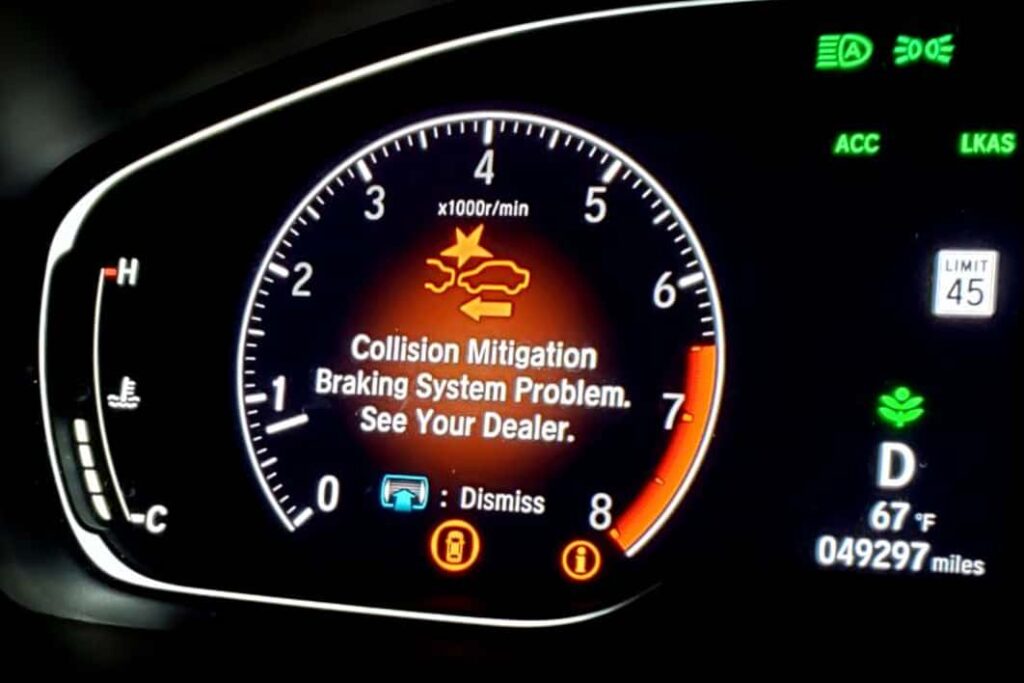Have you been wondering about the most common collision mitigation braking system problem?
While this special feature is beneficial when working correctly, it can be a nuisance when things do not function as they should.
This is why if it is something that you find yourself dealing with, then it helps to have a better understanding of why it happens and what you can do about it.
Consider these important details to help you understand what causes this problem with the collision mitigation braking system – some risks, diagnosis, and troubleshooting techniques. Let’s get started.

Contents
Collision Mitigation Braking System Problem – Why It Happens
In 2013, there were claims by Honda about some issues that arise with the collision mitigation braking system. This is Honda’s autonomous and functional emergency braking system, which is designed to reduce the risks of collisions. It warns drivers when there are obstacles coming their way, and as a result, brakes are triggered when necessary.
Unfortunately, this feature is not without any fault. For instance, owners have reported of the CMBS causing their vehicles to hit the brakes despite having zero obstacles. Thus, there were lawsuits filed against Honda because of this issue. The accidental slamming on their brakes makes it highly likely for the vehicle to get rear-ended. When you are driving fast and then your vehicle stops immediately, accidents can arise.
The CMBS are also triggered when normal road elements were mistaken by this feature as an obstacle. Hence, this makes this feature a concern for affected owners.
With that in mind, it makes people wonder – why does this issue occur, anyway?
There are a few causes to this problem. For instance, there appears to be some defects to the system. When these defects arise, the CMBS causes a random brake engagement, while at the same time decelerating the vehicle suddenly. This can also result in jerking and shuddering, which then leads to safety issues while on the road.
This happens as the collision mitigation braking system sends off false alerts for various obstacles that are not even present. Opposing traffic may be seen as obstacles, which does not detect an actual road obstacle. Various conditions affect the function of the CMBS such as sudden light changes, weather, shadows, and the time of day when driving.
Aside from the sudden halting of the vehicle, there are also other problems that come with the CMBS such as sending loud alerts. This causes the driver to get distracted, which negatively impacts his or her driving.
Issues With the Collision Mitigation Braking System
This issue with the CMBS has resulted in a recall of certain vehicles. Unfortunately, Honda resumed the sale of these vehicles that are known to have issues with the braking system. Certain models were reported to have experienced these braking issues such as the Honda Accord, CR-V, and Pilot with model years 2016 to 2020.
These models and model years have been known to have experienced these defects with the collision mitigation braking system, which increased the likelihood of an accident.
Basically, the CMBS works by improving your safety when driving on the road by minimizing the chances of a collision. It also incorporates the key features of the FCW or the Forward Collision Warning, and it is a part of the vehicle’s sensing function. The CMBS also relies on radar sensors located close to the lower front bumper, as well as the interior camera and a few other safety technologies.
When you experience a problem with the collision mitigation braking system, it is best to apply just light braking. But in some cases, you may need to brake hard to further reduce the chances of a crash.
But when not working correctly, some vehicles experience the CMBS acting up with a close risk of getting rear-ended. Their vehicle mistakenly assumed that there was a road hazard, which caused it to clear off the road. This is why some drivers become wary of driving their vehicles because of this situation.
Another situation reported was when their vehicle saw a shadow on the road, which triggered it to slam on the brakes hard and release without apparent reason. When the driver asked the service manager at the dealership to disable this feature because it was acting up, he was told that it was impossible to do so.
And then, there was the issue with the Honda CR-V when the CMBS malfunctioned while driving over some metal plates put on the road when close to a construction site. Since these plates stick out, the CMBS gets activated and stops abruptly. This increases the possibility of getting rear-ended, especially if there is another vehicle from behind that was not expecting this sudden stop.
As with the other drivers who reported this issue, the car owner was unable to disable this feature permanently. Hence, it only can be turned off manually to prevent this function from getting activated.
The same concerns were reported about the Honda Pilot with model years 2017 and 2019. These vehicles stop immediately even without actual road obstacles and no potential issues for a crash. As a result, there were risks of getting rear-ended, especially when drivers from behind were not expecting for this to happen.
The CMBS is likely to be problematic when you experience certain symptoms such as false obstruction alerts, unexpected highway speed fluctuations, unexpected and sudden braking, and the lane keeping false alerts. When you experience these symptoms frequently, it is best to take your vehicle to a dealership to get these issues addressed sooner than later.
Bottom Line
The Collision Mitigation Braking System problem can be quite concerning when there are chances of a crash or getting rear-ended. Unfortunately, this is a defect to the system without any known causes as it affects even newer vehicles. So, it is best to pay attention to the symptoms of the problem and have your vehicle checked by a specialist to prevent further problems.